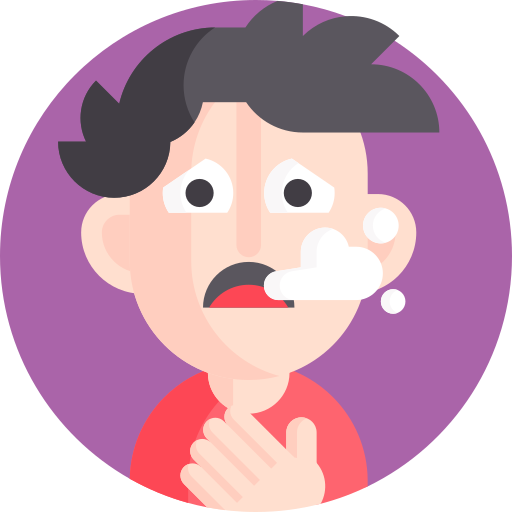
For best results make sure background graphics are enabled.

Asthma is a chronic (life-long) disease that inflames and narrows airways in the lungs, making it hard to breathe. It’s normal for airways to get inflamed and narrow when exposed to smoke, pollution and other irritants. However, children and youth with asthma are sensitive to things that shouldn’t irritate the lungs, like pollen or even the common cold.
Did you know: asthma is the most common chronic disease in children? More than 1 out of 10 children will have asthma at some point in their life.
Types of asthma
There are two types of asthma.
-
Asthma related abnormally to small airways
Some children are born with smaller airways. When they catch a cold, the airways get swollen and inflamed making it much harder to breathe. These children will often outgrow their asthma.
-
Allergic asthma
Children with allergies sometimes develop allergic asthma. They have asthma symptoms when they are exposed to allergens such as dust, pollen and animal fur. They also have asthma symptoms when they catch a cold, and often when they exercise. These children are less likely to outgrow their asthma.
Asthma symptoms
Asthma symptoms range from mild to severe. Children and youth with either type of asthma may have only one, or all three of these symptoms at different times:
- cough that’s excessive compared to other people
- wheezing (high pitched whistling noise when breathing out)
- difficulty breathing or chest tightness
Sometimes, children and youth can’t tell us how they are feeling. If you think your child or youth might have asthma, ask yourself:
- Can my child keep up with others while running around?
- Do they have a hard time catching their breath?
- Do they cough more at night or perhaps even cough so hard they vomit?
Taking care of your child or youth with asthma
Although there is no cure for asthma, with proper treatment your child or youth can enjoy normal active lives.
| Triggers |
| The first step of asthma therapy is avoiding triggers. These are things that make your child’s asthma worse. In children, the most common asthma trigger is the common cold. Other triggers include smoke, pollution, and allergens like dust mites, pollen and animal dander. Avoid smoking People should not smoke near a child with asthma. This includes smoking in a different room of the house or in the car. Even if your child isn’t present while the smoking takes place, they can still be triggered by lingering smoke. Get your family vaccinated against the flu Since the most common asthma trigger in children is the common cold, it’s important to get your annual flu shot. Check air quality Visit Air Quality Ontario's website to check the Air Quality Health Index in your area. This index pays particular attention to people who are sensitive to air pollution, like children and youth, and provides advice on how to adjust their daily activities. Reduce allergens in the home Children and youth with allergic asthma can be triggered by anything they are allergic to. For dust mites, buy dust-mite proof pillow and mattress covers, reduce clutter in the bedrooms, dust and vacuum regularly and remove carpets where possible. For tree and grass pollens, keep the doors and windows closed. If you need a cool breeze, use an air conditioner instead. For animal dander, minimize contact, wash the pet regularly, keep the pet out of the bedroom and consider an air purifier. For molds, clean any areas of mold in the home with soap and water. Use fans to reduce humidity in these areas. You will need professional help to manage large areas of mold. For cockroaches, hire a professional exterminator and keep your child somewhere else while chemicals are being used. |
| Medications |
| There are two types of inhaler medications that are used to control asthma symptoms: relievers and controllers. Your doctor will help you select the right medication(s) depending on your child's symptoms. Always follow their dosing instructions carefully and consult your pharmacist if you have any questions. Reliever (rescue) medications:
Ventolin® is the most common type of reliever inhaler. It starts working within five minutes and lasts for four hours. Children who use this may use it four to six times a day during cold/flu season, during an active asthmas attack, or 15 minutes before exercise if their asthma is exercise-induced. Oxeze® or Foradil® are long-acting reliever medications. They take longer to start working (30 minutes) but last for 12 hours. Controller medications Most controller medications are inhaled steroids. They contain very small amounts of steroid. Common controller medications include Flovent®, Alvesco®, Pulmicort® and Asmanex®. When these medications are given by a metered-dose inhaler type of puffer, they should be used with a spacer device to prevent thrush and ensure your child gets the maximum dose. They:
It’s very important that you learn proper inhaler technique to maximize the dose your child receives. Inhaler medications will only work if they reach your child’s lungs. Singulair® is another controller medication that reduces inflammation of the airways, but it doesn’t contain any steroids. It's given in pill (or sprinkle) form and takes up to three weeks to start working. Side effects include headache, stomach aches, and behavior changes. Combination inhalers contain a long-acting reliever and an inhaled steroid. These medications include Symbicort®, which contains the medications in Pulmicort® and Oxeze®, Advair, which contains the medications in Flovent® and Serevent, and Zenhale®, which contains the medications in Foradil® and Asmanex®. They provide long-term improved asthma control, reducing symptoms (including with exercise) and improving lung function. These medications need to be taken twice a day. When Symbicort® is used, extra doses can be given during asthma attacks, instead of a reliever inhaler. |
| Asthma attacks |
| Symptoms of an asthma attack include:
If your child is having an asthma attack:
|
Call 911 or go to the Emergency Department if you notice:
• blue skin
• severe cough or wheezing that returns within four hours of using the child’s reliever medication (salbutamol or Ventolin)
• inability to speak in full sentences because of difficulty breathing
• becoming tired or sleepy because of difficulty breathing
• fainting because of an asthma attack
 Looking for translation?
Looking for translation?
Did you know: our care resources can be translated into over 100 languages using Google Translate! Click the Translate button on the top right corner of your screen and select your preferred language to get started.
Disclaimer
This resource is for educational purposes only, and was originally written in English and translated to French. Translation to any other languages is automatically provided through Google Translate, and not official. There may be subtle differences or inaccuracies. If you have any questions about medical matters including your care and treatment, please reach out to your health-care team.




